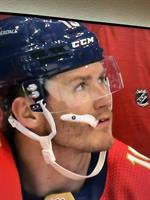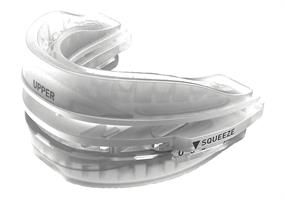Have you ever noticed NHL players chewing on their mouthguards during games? This growing trend, popularized by players like Matthew Tkachuk, mouthguard-chewing enthusiast, and Patrick Kane, has sparked heated debates among fans and athletes alike. Is it a display of confidence or a distraction on the ice?
In this article, we’ll explore the origins, benefits, and drawbacks of Matthew Tkachuk mouthguard-chewing in the NHL and beyond.

Key Takeaways
-
Matthew Tkachuk’s habit of continuously chewing on his mouthguard during NHL games has been inspired by Patrick Kane and serves as a way to relieve stress.
-
The Tkachuk brothers have different styles of mouthguard-chewing that contribute to their individual identities, with pros and cons for the players.
-
Fans have expressed diverse reactions and opinions regarding Matthew Tkachuk’s habit, sparking debates over whether it is seen as an expression of confidence or a distraction from the game.
The Habit Behind the Mouthguard
Matthew Tkachuk, a forward for the Florida Panthers, is well-known for his habit of constantly chewing on his mouthguard during NHL games. This signature move has become a talking point among fans and commentators alike.
But where did this habit come from?
The Influence of Patrick Kane
Growing up as a fan of Patrick Kane, Matthew Tkachuk drew inspiration from Kane’s unique mouthguard-chewing style and decided to adopt it. Kane’s approach, with the mouthguard half in and half out, exuded an air of nonchalance and swagger as if he had stopped wearing it properly.
Patrick Kane started chewing on his mouthguard for comfort during his initial NHL years, which soon turned into a recognizable attribute of his on-ice persona. This habit has influenced other young players, like Tkachuk himself, much like how basketball player Steph Curry chews on his mouthguard during games.
Little Stress Reliever
The act of chewing on a mouthguard can have several benefits for athletes, including:
-
Distraction from game pressure, aiding in stress and anxiety relief
-
Improved focus and concentration
-
Diversion of attention from the intensity of the game
-
Achieving a soothing effect
Many athletes across various sports have adopted mouthguard-chewing as a way to enhance their performance and mental state during games, protecting their mouth in the process.
Nonetheless, the absence of a mouthguard can lead to dental issues like chipped or broken teeth, along with jaw and facial injuries.
The Tkachuk Brothers and Their Mouthguards
Not only Matthew Tkachuk but also other family members display a fondness for chewing on mouthguards. His brother, Brady Tkachuk, also shares this habit, making it a distinctive trait among the Tkachuk siblings. Both brothers play in the NHL and have been observed chewing on their mouthguards during games.
Their mother has voiced concerns over potential tooth damage the brothers might inflict on each other due to their habit of chewing mouthguards. Despite her worries, it seems that this shared habit is here to stay and has become an integral part of the Tkachuk brothers’ on-ice presence.
Chewing Runs in the Family
The Tkachuk family’s association with mouthguards can be traced back to the NHL playing days of Matthew’s father, Keith. Known for his aggressive style of play, Keith was often seen chewing on his mouthguard during matches. This practice has been passed down from father to sons, with both Matthew and Brady adopting the habit.
The mouthguard-chewing habit is believed to have been introduced to the Tkachuk family by Patrick Kane, a former teammate of Keith Tkachuk. Kane’s aggressive style of play and mouthguard-chewing have influenced the Tkachuk brothers, making it a family characteristic that has spanned generations.
Comparing Styles
While both Tkachuk brothers engage in mouthguard-chewing, there are some differences in their habits. Matthew chews on his mouthguard more often than Brady, making it a more noticeable aspect of his on-ice persona.
These variations in the brothers’ mouthguard-chewing styles add to the unique identities they bring to the ice, further contributing to their individual impact on the game and their growing fanbases.
The Mouthguard Phenomenon in the NHL
NHL players like Patrick Kane, Clayton Keller, and Leon Draisaitl have popularized the practice of mouthguard-chewing, making it increasingly common in the league. This habit has sparked debates on whether it’s a positive trend or a distraction from the game.
Though mouthguard-chewing is not exclusive to the NHL, it has undoubtedly become a defining characteristic of certain players in the league. The increased visibility of this habit has led to discussions on its benefits and drawbacks, as well as its impact on the sport overall.
A Trend Among Athletes?
The prevalence of mouthguard-chewing extends beyond the NHL, as it’s become a common trend among athletes in a variety of sports. The use of mouthguards has been adopted in sports like:
-
basketball
-
boxing
-
football
-
martial arts
-
rugby
-
and many others
To protect athletes from dental injuries and other related traumas, it’s crucial to take preventive measures from the first round of their sports activities.
The advantages of the mouthguard-chewing trend include increased focus, improved performance, and reduced stress. However, there are also disadvantages such as potential damage to the mouthguard, increased risk of injury, and distraction from the game. Athletes need to be cognizant of these risks and adopt necessary safety measures.
The Pros and Cons
Mouthguard-chewing offers several benefits for NHL players, including:
-
Protection against bruxism and sports-related trauma
-
Reduction of jaw tension and pain
-
Prevention of teeth damage
-
Alleviation of TMJ pain
-
Improved airflow during sleep
On the other hand, the drawbacks of mouthguard-chewing in the NHL include potential distractions from the game, the risk of choking, and damage to the mouthguard itself. It is crucial for players to consider these risks and ensure they’re using mouthguards properly to maximize protection and minimize potential issues.
Mouthguard Safety and Awareness
The significance of mouthguard safety and awareness is paramount. Wearing a mouthguard can assist in reducing the risk of concussion, jaw fractures, and other dental injuries, making it a vital piece of protective equipment for athletes in contact sports.
Failure to wear a mouthguard can result in serious dental injuries, such as broken teeth, jaw fractures, and concussions. Athletes must prioritize correct mouthguard usage and maintain awareness of potential dangers stemming from its non-use to prevent these risks.
Proper Fit and Care
For effective protection, a mouth guard must fit well. It should fit snugly and securely on the upper teeth without the need for the tongue to hold it in place. Mouth guards should also fit comfortably on the lower teeth, ensuring that they don’t impede breathing or speaking.
Mouthguard care holds equal importance. After use, follow these steps to keep your mouthguard clean and in good condition:
-
Rinse it in cool water.
-
Apply a small amount of soap.
-
Gently brush it. Proper care will help maintain the mouthguard’s effectiveness and prolong its lifespan.
Risks of Not Wearing a Mouthguard
Engaging in sports activities without a mouthguard can lead to serious injuries like broken teeth, jaw fractures, and concussions. These risks underscore the importance of wearing a properly fitted mouthguard and taking the necessary precautions to protect one’s dental health.
To ensure the effectiveness of mouthguards, it’s necessary to ensure a proper fit and provide adequate care. A mouthguard that is not fitted correctly, either too loose or too tight, can be uncomfortable and can also diminish the effectiveness of the mouthguard, putting the wearer at risk.
Fans' Reactions and Opinions
Matthew Tkachuk’s proclivity for chewing his mouthguard has elicited diverse reactions and opinions from fans. Many commend him for his unique style of play and view the mouthguard-chewing as a demonstration of his concentration and intensity on the ice.
Yet, some spectators oppose Tkachuk’s habit of mouthguard-chewing, contending that it causes disruptions and detracts from the game. This debate highlights the varied opinions surrounding mouthguard-chewing in the NHL and its impact on the sport.
Social Media Buzz
Tkachuk’s mouthguard-chewing habit has sparked fervent debates on social media, with fans arguing over its symbolism—confidence or a mere diversion. This discussion has led to a wide range of opinions, showcasing the diverse perspectives of fans and the continued interest in this unique habit.
While some fans perceive the mouthguard-chewing as a display of confidence adding to the game’s entertainment, others consider it a distraction that takes away from the game. Ultimately, the merits and drawbacks of mouthguard-chewing are a matter of personal preference and context.
The Debate: Swagger or Distraction?
The ongoing discourse about Matthew Tkachuk’s mouthguard-chewing habit hinges on whether it exhibits assurance or presents a hindrance on the ice. Fans are divided on this issue, with some praising the habit as a display of confidence, while others view it as a distraction from the game.
While there are potential advantages and disadvantages to mouthguard-chewing, it ultimately comes down to personal preference and the specific context in which it occurs. As the debate continues, it’s clear that mouthguard-chewing will remain a hot topic in the world of hockey.
Summary
Mouthguard-chewing in the NHL is a growing trend that has sparked much debate among fans, players, and experts. From its origins with players like Patrick Kane and Matthew Tkachuk to its adoption by athletes across various sports, this unique habit has garnered significant attention.
As we’ve explored the advantages and drawbacks of mouthguard-chewing, as well as the importance of proper mouthguard use and safety, it’s evident that this trend will continue to be a topic of discussion in the world of sports.
So, whether you view it as swagger or distraction, one thing is for sure: mouthguard-chewing is here to stay.
Frequently Asked Questions
Why does Matthew Tkachuk chew on his mouthpiece?
Matthew Tkachuk has stated that he is unsure of the origin or reason why he chews on his mouthguard, though he theorizes it may be to act as a stress reliever.
Why do NHL players chew on their mouth guards?
Chewing on a mouthguard is a way for professional athletes to find the right “bite”, as it helps their jaw move around repeatedly. As a result, NHL players may chew on their mouth guards to achieve this.
What kind of mouthguards do NHL players wear?
NHL players wear custom-fitting mouthguards which provide more protection than the off-the-shelf boil-n-bite versions available at your local store.
Where do NHL players get their mouthguards?
Most NHL players get their mouthguards from dentists or dental labs, who craft a custom 3 mm guard based on impressions of their teeth.
Who popularized the mouthguard-chewing habit in the NHL?
Patrick Kane is credited with popularizing the mouthguard-chewing habit in the NHL, becoming a trendsetter among players.


